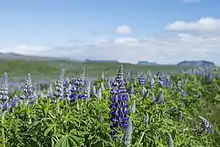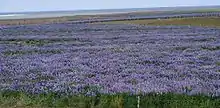Lupinus nootkatensis
Lupinus nootkatensis, the Nootka lupine,[1] is a perennial plant of the genus Lupinus in the legume family, Fabaceae. It is native to North America. The Nootka lupine grows to 60 cm tall. Late in the 18th century it was first introduced to Europe.[2]


| Lupinus nootkatensis | |
|---|---|
 | |
| Nootka lupine growing in Iceland. | |
| Scientific classification | |
| Kingdom: | Plantae |
| Clade: | Tracheophytes |
| Clade: | Angiosperms |
| Clade: | Eudicots |
| Clade: | Rosids |
| Order: | Fabales |
| Family: | Fabaceae |
| Genus: | Lupinus |
| Species: | L. nootkatensis |
| Binomial name | |
| Lupinus nootkatensis Donn ex Sims | |
The Nootka lupine is common on the west coast of North America, and is one of the species from which the garden hybrids are derived, being valued in Britain and other North-European countries for its tolerance of cool, wet summers. In North-America, it grows along roadsides, gravel bars, and forest clearings from the Aleutian Islands and Southcentral Alaska, and along the Alaskan panhandle to British Columbia. Rigorous self-seeders as they are, lupine can often be seen along roadsides and in open meadows, their bright blueish purple flowers catching ones eye from quite a distance. Their long tap roots make transplanting difficult, so sowing seed is preferable.
Taxonomy
The species was first described as Lupinus nootkatensis in 1810 by James Donn in Botanical Magazine, Vol. 32, Page 1311.[3]
On the Plant List the species is divided in two varieties:[4]
- Lupinus nootkatensis var. fruticosus Sims
- Lupinus nootkatensis var. nootkatensis is the subspecies.
Toxicity
A member of the pea family (Fabaceae), lupines form seeds in fuzzy pods that may be attractive to children. The seeds of the lupine can be toxic, though toxins flush through the system quickly and are not cumulative. However, internal use is not advised.[5]
Nootka lupine in Iceland
In Iceland, the Nootka lupine has been designated an invasive species.[6] The plant was introduced in the first half of the 20th century to combat erosion, speed up land reclamation and help with reforestation. Dense lupine cover and soil fertility can be gained within a relatively short time span, where the growth of the lupine is not limited by droughts.[7] The lupine is well suited for reclamation of large, barren areas because of its nitrogen fixation and rapid growth. Furthermore, it has an ability to extract phosphorus from compounds in poor soils.[8] In spite of these good qualities, it has a tendency to become dominant and to colonize already vegetated areas such as dwarf shrub-highlands, where it overtakes the natural flora and threatens biodiversity. The plant has spread from the loose, eroded soil in which it was originally planted and is now found throughout the lowlands of Iceland.[9]
The initial expectation was for the Nootka lupine to retreat gradually along with increased fertility of the soil and give way for other species. This is evident on sites in Iceland where the lupine was introduced early, such as in Heiðmörk near Reykjavík.[10] However, plant succession is towards a forb-rich grassland, often dominated by the invasive species Anthriscus sylvestris, meaning that careful management of lupine is necessary to prevent it from colonizing areas where its presence is not desirable.[11]
References
- "Lupinus nootkatensis". Natural Resources Conservation Service PLANTS Database. USDA. Retrieved 1 March 2016.
- Magnusson, B. (2006): NOBANIS – Invasive Alien Species Fact Sheet – Lupinus nootkatensis. – From: Online Database of the North European and Baltic Network on Invasive Alien Species – NOBANIS www.nobanis.org, Date of access 31 October 2008.
- http://babel.hathitrust.org/cgi/pt?id=hvd.32044106372972
- http://www.theplantlist.org/tpl1.1/search?q=Lupinus+nootkatensis
- http://davesgarden.com/guides/pf/go/51569/#ixzz3pfpYktlh
- Icelandic Institute of Natural History, Invasive Plants in Iceland, accessed 7 May 2019
- Biological Diversity in Iceland (2001). National Report to the Convention on Biological Diversity. Ministry for the Environment and the Icelandic Institute of Natural History
- Sigurður Arnarson (2014). Belgjurtabókin. Sumarhúsið og garðurinn.
- Borgthor Magnusson, "NOBANIS – Invasive Alien Species Fact Sheet: Lupinus nootkatensis," pp. 4-5
- Daði Björnsson (2011). Hörfar lúpínan? Dæmi úr Heiðmörk. (Does lupine retreat? The case of Heiðmörk) Skógræktarritið, The Journal of the Icelandic Forestry Association, the second issue of 2011. Skógræktarfélag Íslands.
- Borgthor Magnusson, "NOBANIS – Invasive Alien Species Fact Sheet: Lupinus nootkatensis," pp. 7-9
Sources
| Wikimedia Commons has media related to Lupinus nootkatensis. |
- Accessed 31 October 2008.
- Biological Diversity in Iceland. National Report to the Convention on Biological Diversity. Ministry for the Environment and the Icelandic Institute of Natural History. 2001.
